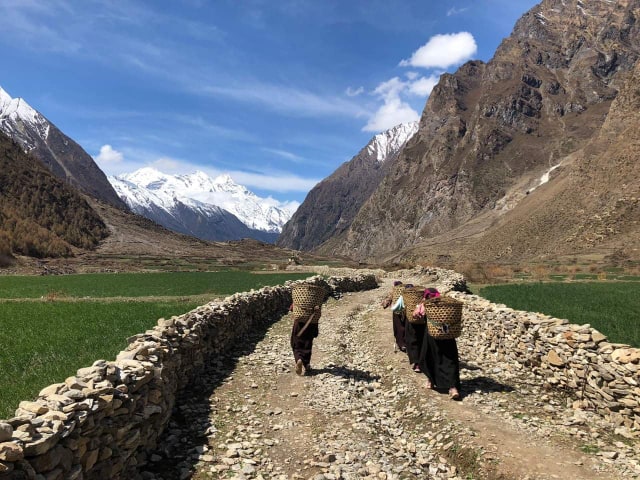Monsoon in Nepal, typically from June to August, is synonymous with heavy rains, misty mountains, and blooming greenery. But does that mean trekking is off the table?
Not at all! In fact, some of the best monsoon trekking in Nepal lie in rain-shadow regions that receive very little rainfall, offering spectacular views and cultural experiences even in July and August.
| Feature | Details |
|---|---|
| Season Months | June to August |
| Rainfall Pattern | Daily afternoon/evening showers, especially in central & eastern regions |
| Temperature | 20–30°C in lower hills, cooler in higher altitudes |
| Terrain | Lush green, slippery trails, occasional leeches |
| Best Regions | Rain-shadow zones like Upper Mustang and Dolpo |
June, July and till Agust is raining fall in monsoon season in Nepal and July is least visit month of the year. It is the best time for the excellent trekking, Generally, most of the tourist do not prefer doing activities such as trekking during the monsoon. But we can assure you that, if you are visiting Nepal during July, you will get the various trek option routes too. Those trekking routes you can easily escape the monsoon trails. As like-upper Mustang, Upper Dolpa, Rara Trek, Nar Phu Valley treks, Ghore pani Poon Hill, Jomsom treks, this is Best Destinations for Trekking in Nepal in July.
Here are the top-rated treks that are safe, beautiful, and logistically accessible even during the rainy season:
Region: Rain-shadow area in northwest Nepal
Duration: 12–14 Days
Max Altitude: 3,840 m
Why in Monsoon: Virtually no rainfall, dry terrain
Highlights:
Lo Manthang royal city
Ancient caves and Tibetan culture
Red-rock cliffs and arid landscapes
Region: Annapurna region (north of Manang)
Duration: 12–15 Days
Max Altitude: 5,300 m
Why in Monsoon: Shielded from monsoon by Annapurna range
Highlights:
Remote Tibetan villages
Hidden valleys and stone-fort villages
Optional extension to Annapurna Circuit
Region: Mid-western Nepal
Duration: 20–25 Days
Max Altitude: 5,190 m
Why in Monsoon: Lies in Trans-Himalayan rain shadow
Highlights:
Shey Phoksundo Lake
Isolated Tibetan Buddhist culture
Wild, raw terrain rarely seen by outsiders
Region: Annapurna Region
Duration: 7–9 Days
Max Altitude: 3,800 m
Why in Monsoon: Dry trails, quick access via flight to Jomsom
Highlights:
Sacred temple at Muktinath
Kali Gandaki Gorge
Himalayan desert scenery
Region: Annapurna foothills
Duration: 4–5 Days
Max Altitude: 3,210 m
Why in Monsoon: Short trek, flexible schedule
Highlights:
Panoramic sunrise view
Rhododendron forests, village stays
Frequent rainbows and vibrant landscapes
Region: Near Ghorepani
Duration: 6–9 Days
Max Altitude: 3,660 m
Why in Monsoon: Less touristy, rich vegetation
Highlights:
Remote ridge trails
Community lodges
Stunning Dhaulagiri & Annapurna views
Region: Western Nepal
Duration: 9–10 Days
Max Altitude: 3,050 m
Why in Monsoon: Less rainfall, isolated trail
Highlights:
Nepal’s largest lake
Wild nature and blue waters
Optional jeep drive + flight access

You are most welcome monsoon trekking in Nepal, you can see some picture and read some information about the trip to Monsoon
July month is a raining season in Nepal Kathmandu and as a result, it receives the most amount of rain all year. It generally rains around 350mm and the average temperature in Kathmandu in July is 24Dc and dropping lows of around 20 DC
Here is our best trip list to do in Nepal in July in the Monsoon, we have many trekking options, some part of Nepal, amazing Panoramic flight over the Himalayas, Visit the Royal Chitwan national park and Bardia national park, Exploring Kathmandu and Pokhara city, Mount Everest Helicopter tour,
Yes, with careful planning. Trek only in recommended monsoon zones, avoid landslide-prone trails, and use licensed guides.
Avoid treks in the Everest region during peak rain months
Wear waterproof boots and gaiters
Carry anti-leech socks
Use a local trekking company like Nepal Planet Treks for logistic support and safety assurance.
Yes, especially in rain-shadow areas like Mustang and Dolpo. Avoid central hill regions where landslides are common.
Only in selected areas like Upper Mustang, Jomsom, and Dolpo. These regions remain dry and scenic.
Subjective, but many travelers love Everest Base Camp, Annapurna Base Camp, and Upper Mustang for scenery.
The Great Himalayan Trail and Kanchenjunga Base Camp are among the most challenging due to remoteness and duration.
Yes, Thamel is safe for tourists at night. Stick to main roads and avoid isolated alleys.
The Trans-Himalayan region, especially near Lomanthang and Dolpo, can experience sub-zero temperatures even in summer.